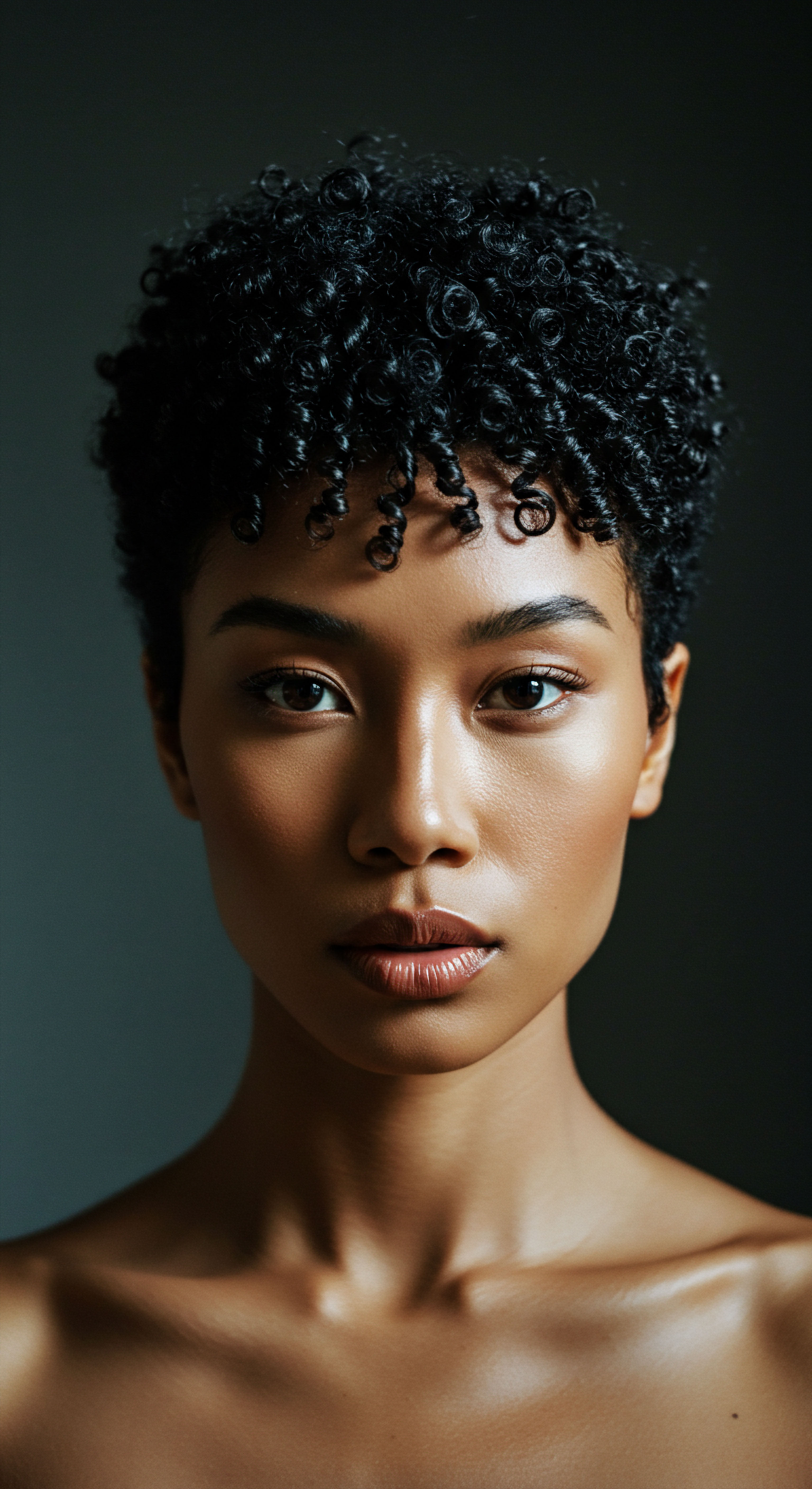
Roots
The story of textured hair wellness begins not in a laboratory, nor in a beauty aisle, but in the sun-drenched landscapes of Africa, where generations have lived in deep connection with the earth. Here, knowledge of hair was not merely about appearance; it was a living tradition, a quiet wisdom passed down through hands and voices. It was an understanding of strands that went beyond surface texture, recognizing hair as a conduit for identity, a symbol of belonging, and a reflection of spiritual alignment. The practices developed within these communities laid foundational principles that, though often overlooked in modern discourse, continue to inform a truly comprehensive approach to hair health.
Consider the intricate biology of textured hair, often characterized by its unique elliptical follicle shape and a cuticle layer that naturally lifts at various points along the strand. This inherent structural quality means textured hair possesses a distinct relationship with moisture, absorbing it readily but also releasing it with similar speed. Traditional African practices, developed long before scientific instruments could reveal these microscopic details, intuitively accounted for this very nature.
They recognized the hair’s thirst and its need for gentle, consistent replenishment, leading to regimens that prioritized hydration and protection. This deep, observant understanding formed the initial layer of hair care wisdom.

Hair’s Own Architecture
The architecture of hair, particularly for those with coils and curls, differs significantly from straighter forms. Each strand emerges from an elliptical follicle, a shape that contributes to the hair’s characteristic curves and bends. Along these curves, the outer cuticle layer, composed of overlapping scales, tends to rise slightly. This structural attribute, while contributing to the hair’s magnificent volume and resilience, also affects how moisture enters and exits the hair shaft.
This open nature, or what modern science terms ‘porosity,’ meant that ancient African communities instinctively gravitated towards emollients and humectants that could both deliver and seal in hydration. Their observations, refined over centuries, mirrored the scientific insights we now hold concerning the specific needs of these unique hair structures.

How does Hair Porosity Influence Traditional African Hair Care?
Hair porosity, essentially the hair’s ability to absorb and hold moisture, plays a central role in how traditional African hair care was, and still is, approached. Textured hair often exhibits varying degrees of porosity, with some strands having a more open cuticle structure, allowing water to enter quickly but also to escape with ease. This can lead to a sensation of dryness. Conversely, hair with tightly closed cuticles may resist water entry but retain moisture once it penetrates.
Traditional methods did not use the term ‘porosity,’ yet their practices intuitively addressed these differences. For instance, the consistent use of rich butters and oils helped seal the more open cuticles, reducing moisture loss. For hair that resisted water, warm water rinses or steaming, a precursor to modern deep conditioning techniques, would gently encourage the cuticle to lift, allowing beneficial plant infusions to truly penetrate. This adaptive approach highlights a sophisticated, empirical understanding of hair’s interaction with its environment.
Traditional African hair care, shaped by centuries of observation, instinctively responded to the unique moisture dynamics of textured hair, long before scientific terminology for porosity existed.

The Ancient Lexicon of Hair
Beyond scientific understanding, a rich lexicon surrounded hair within African cultures. It was not merely ‘hair’ but often referred to with terms that denoted its sacredness, its connection to lineage, or its role in social identification. Hairstyles themselves were living texts, communicating age, marital status, tribal affiliation, and even social standing. The tools used, such as combs carved from wood or ivory, were often adorned with symbols, rendering them more than mere grooming instruments; they became artifacts imbued with spiritual meaning.
These objects, often buried with their owners, attest to the profound reverence held for hair and its care. This historical regard contrasts sharply with later colonial narratives that sought to diminish the cultural significance of African hair.
Traditional African societies employed various methods to categorize hair, moving beyond simple curl patterns. Their ‘hair mapping’ practices encompassed factors such as how hair responded to water, its density, its elasticity, and its reaction to local environmental conditions. This comprehensive framework guided the selection of specific plant-based ingredients and styling methods.
- Hair Density ❉ Traditional practitioners observed how many strands grew from a given area of the scalp, informing the amount of product and tension applied during styling.
- Hair Elasticity ❉ The ability of hair to stretch and return to its original state was a key indicator of its health, guiding the choice of gentle detangling methods and conditioning treatments.
- Environmental Response ❉ Local climates, from arid deserts to humid rainforests, influenced hair’s needs, leading to regional variations in botanical remedies and care practices.
This intricate understanding, developed through generations of lived experience and keen observation, forms the very roots of modern hair wellness for textured hair. It reminds us that the most profound insights often come from a patient, respectful relationship with the natural world and our own bodies.

Ritual
Stepping from the foundational insights into the daily practices of hair wellness, we find ourselves immersed in the rituals that have shaped African hair care for centuries. These are not simply routines, but acts of conscious care, deeply embedded in community and personal identity. Each application of a botanical balm, each intricate braid, each moment spent tending to strands, represents a continuation of ancient wisdom, adapted and refined. Modern hair wellness, particularly for textured hair, gains immense depth when we recognize the enduring value of these time-honored techniques and the profound connection they represent.

The Practical Application of Botanical Knowledge
The African continent’s rich biodiversity provided a veritable apothecary for hair care. Plants were not merely ingredients; they were partners in maintaining scalp health and strand vitality. Shea butter, extracted from the nuts of the Vitellaria paradoxa tree, stands as a prime example. For millennia, it has been a staple in West Africa, used to moisturize skin and hair, protect against the sun, and calm scalp irritations.
Its abundance of fatty acids, including linoleic, oleic, stearic, and palmitic acids, seals moisture into the hair, enhancing shine and reducing frizz. This natural sealant is particularly valuable for textured hair, which benefits immensely from moisture retention.
Another remarkable botanical is moringa oil, derived from the seeds of the ‘Miracle Tree.’ Found in parts of Africa and Asia, moringa has been used traditionally for its wide array of medicinal properties, including those that support healthy hair growth. It is rich in protein, zinc, silica, vitamin A, calcium, and magnesium, all vital for reinforcing hair follicles. Moringa oil’s ability to penetrate the hair shaft and smooth the cuticle helps reduce breakage and tangles, encouraging healthy hair growth.
| Botanical Name Shea Butter (Vitellaria paradoxa) |
| Traditional Use Region West Africa, East Africa |
| Key Hair Benefits Moisturizing, sealing, anti-inflammatory, UV protection. |
| Botanical Name Moringa Oil (Moringa oleifera) |
| Traditional Use Region Various African regions, Asia |
| Key Hair Benefits Strengthening follicles, moisturizing, growth stimulation, anti-dandruff. |
| Botanical Name Baobab Oil (Adansonia digitata) |
| Traditional Use Region Various African regions |
| Key Hair Benefits Nourishing, conditioning, elasticity. |
| Botanical Name African Black Soap |
| Traditional Use Region West Africa |
| Key Hair Benefits Cleansing, clarifying scalp. |
| Botanical Name These natural ingredients, long relied upon in African communities, form the basis of many modern hair wellness products. |

Styling as Protection and Communication
Beyond the application of botanical remedies, traditional African hair care rituals included a diverse array of styling techniques that served both aesthetic and protective purposes. Braids, twists, and cornrows were not merely decorative; they shielded delicate strands from environmental aggressors, reduced tangling, and minimized breakage. These styles allowed hair to retain moisture for longer periods, promoting overall strand health. The cultural meaning embedded in these styles was profound, often conveying social status, age, or even marital status within a community.
Traditional African styling practices, such as braiding and twisting, were not just aesthetic choices but served as vital protective measures, preserving hair health and communicating social meaning.

How Did Ancient African Hair Tools Shape Hair Care Practices?
Ancient African hair tools, particularly the Afro comb, played a significant role in shaping hair care practices. Archaeological discoveries in Kush and Kemet (modern-day Sudan and Egypt) reveal wooden, bone, and ivory combs dating back over 5,500 to 7,000 years. These combs, often intricately carved with symbols, were not only functional for detangling and styling but also held spiritual and cultural significance, sometimes buried with their owners. Their wide-toothed design was perfectly suited for navigating the coils and curls of textured hair, minimizing breakage during grooming.
This early design principle, prioritizing gentle manipulation over harsh force, remains a cornerstone of effective textured hair care today. The deliberate creation of tools tailored to specific hair textures underscores a sophisticated, practical understanding of hair’s unique needs.
The tools and techniques developed across Africa were inherently aligned with the structural properties of textured hair. They were designed to minimize manipulation, protect ends, and encourage natural growth patterns. This mindful approach to styling stands in stark contrast to practices that seek to forcibly alter hair’s natural state, often leading to damage. The resilience of these traditional methods, enduring through centuries and even periods of immense cultural disruption, speaks to their efficacy and their deep connection to hair’s innate well-being.

Relay
As we consider the journey from ancient traditions to contemporary hair wellness, we find a complex interplay of knowledge, adaptation, and ongoing dialogue. The wisdom passed down through African ethnobotanical traditions does not simply exist in a historical vacuum; it actively informs, challenges, and enriches modern approaches to textured hair care. This relay of understanding transcends simple ingredient lists, delving into the very philosophy of how we approach hair health, self-perception, and even global commerce. It is a space where science, culture, and ethics converge, inviting a deeper, more reflective engagement with our strands.

Bridging Traditional Knowledge and Scientific Inquiry
The scientific community is increasingly recognizing the verifiable efficacy of many African botanicals long utilized in traditional hair care. This recognition represents a crucial bridge between ancestral wisdom and modern cosmetic science. Research endeavors are now systematically examining the compounds within these plants, seeking to understand their mechanisms of action. For instance, a comprehensive review identified sixty-eight African plants traditionally used for various hair conditions, including alopecia, dandruff, and tinea.
Among these, thirty species have scientific research supporting their use for hair growth and general hair care. These studies often investigate effects such as 5α-reductase inhibition, a mechanism relevant to androgenetic hair loss, and impacts on biomarkers like vascular endothelial growth factor (VEGF), which supports follicle health.
One compelling illustration of this convergence lies in studies on Elephantorrhiza elephantina, a medicinal plant indigenous to southern Africa. Researchers have developed an extract, BP05, from its rhizomes. This extract has been clinically shown to inhibit the enzyme steroid 5-alpha reductase, an enzyme implicated in male pattern baldness. In an in vivo study, a scalp serum containing two percent BP05 extract, when applied over three months, led to an improvement in the pilar formula.
This was characterized by a decrease in the proportion of hair in the telogen (resting) phase and an increase in the anagen (growing) phase. Notably, seventy percent of the test subjects reported a deceleration of hair loss and an increased speed of hair growth. This particular finding, stemming from rigorous scientific validation of a traditionally used plant, offers a powerful testament to the efficacy embedded within African ethnobotanical heritage.
The implications extend beyond specific ingredients. Traditional African ‘hair mapping’ practices, which consider porosity, density, elasticity, and environmental responses alongside curl patterns, offer a more comprehensive framework than simplistic Western classification systems. Modern hair care is beginning to adopt these multi-dimensional assessments, recognizing that a truly personalized approach must account for the full spectrum of hair’s characteristics, as understood by traditional communities for centuries.

Ethical Considerations and Cultural Property
As modern beauty industries look to African botanicals for inspiration, critical questions arise regarding ethical sourcing and intellectual property. The historical exploitation of indigenous knowledge and biological resources necessitates a conscientious approach. Fair trade agreements and direct partnerships with local communities, often women’s cooperatives responsible for harvesting and processing ingredients like shea butter, are paramount. These collaborations not only ensure fair compensation but also contribute to economic independence and the preservation of traditional knowledge.
The integration of African ethnobotanical traditions into modern hair wellness calls for ethical sourcing and fair benefit-sharing, acknowledging the intellectual property inherent in ancestral knowledge.
The concept of intellectual property, particularly concerning traditional knowledge, is a complex arena. Traditional knowledge, often collective and intergenerational, does not fit neatly into Western intellectual property frameworks that emphasize individual ownership. Yet, there is a growing global movement, including discussions within the World Intellectual Property Organization (WIPO), to recognize and protect the rights of indigenous and local communities over their traditional knowledge. This includes mechanisms like disclosure requirements for patent applications based on traditional knowledge, aiming to prevent misappropriation and ensure equitable benefit sharing.
- Fair Compensation ❉ Ensuring that communities providing raw materials and traditional knowledge receive equitable financial returns for their contributions.
- Prior Informed Consent ❉ Obtaining permission from traditional knowledge holders before their practices or resources are utilized for commercial purposes.
- Benefit Sharing ❉ Establishing agreements that ensure a portion of the profits generated from products derived from traditional knowledge is returned to the originating communities.

Hair as a Symbol of Resilience and Identity
The contributions of African ethnobotanical traditions extend beyond tangible products and scientific validation; they profoundly influence the cultural and psychological aspects of hair wellness. Throughout history, African hair has been a powerful symbol of identity, resistance, and self-acceptance, especially in the face of colonial attempts to devalue natural textures. The forced shaving of heads during the transatlantic slave trade was a deliberate act to strip individuals of their identity and cultural ties. Despite these pressures, traditional hair practices persisted, often serving as a silent act of defiance and a connection to ancestral roots.
Modern hair wellness, therefore, gains a deeper dimension when it acknowledges this rich historical context. It is not simply about physical health but about reclaiming narratives, celebrating diverse beauty standards, and affirming cultural heritage. By honoring the origins of these traditions, modern hair care becomes a vehicle for empowerment, fostering a sense of pride and connection for individuals with textured hair worldwide. The relay of knowledge from ancient Africa to today is a continuous flow, enriching not only our understanding of hair but also our appreciation for human resilience and ingenuity.

Reflection
The journey through Africa’s ethnobotanical traditions reveals a profound wisdom, one that quietly instructs us on the enduring power of nature and the deep cultural significance of hair. It shows us that true hair wellness is not a fleeting trend, but a continuous conversation between ancestral knowledge and contemporary understanding, a delicate dance between the earth’s gifts and our personal connection to them. As we look ahead, the whispers of ancient practices continue to guide, inviting us to approach our hair not as a challenge to be conquered, but as a crown to be cherished, a living link to stories untold and wisdom yet to be fully appreciated.

References
- Adejo, A. E. & Adejo, E. A. (2024). Cosmetopoeia of African Plants in Hair Treatment and Care ❉ Topical Nutrition and the Antidiabetic Connection? Diversity, 16(2), 96.
- Oforiwa, A. (2023). The History and Culture of African Natural Hair ❉ From Ancient Times to Modern Trends. AMAKA Studio.
- Oforiwa, A. (2021). The “Dreaded” Colonial Legacy. The Gale Review.
- Afriklens. (2024). African Hairstyles ❉ Cultural Significance and Legacy.
- Al-Snafi, A. E. (2015). The pharmacological importance of Moringa oleifera ❉ A review. International Journal of Pharmaceutical Science and Research, 6(12), 5133-5140.
- Okafor, E. N. & Ogbunugafor, H. A. (2024). The Benefits of African Shea Butter in Skin Care and Hair care Products. ResearchGate.
- CURLYTREATS Festival. (2025). Afro comb ❉ the cultural and political legacy behind this iconic hair tool.
- Natural Poland. (2025). Inspiring African Scents in Modern Fragrance and Skincare.
- FabFitFun. (2025). Behind the Brand ❉ How African Botanics Is Changing Beauty for the Better.
- Healthline. (2018). Shea Butter for Hair ❉ Raw, Hair Growth, and Natural Hair.
- NYSCC. (2020). An Overview on Hair Porosity.
- WIPO. (2023). Intellectual Property Protection and Traditional Knowledge.
- Africa Rebirth. (2022). The African Tales of The Historical 7000 Year Old Afro Comb.
- Natura Africa. (2025). From Harvest to Bottle ❉ How Natura Africa Sources Its Ingredients Sustainably.
- WAAM Cosmetics. (2025). Discover Africa’s many beauty secrets.
- Afrika Warehouse. (2021). Shea Butter – A Multitude of Uses and Benefits.
- European Society of International Law. (2024). ESIL Reflection – WIPO’s New Treaty on Intellectual Property, Genetic Resources and Traditional Knowledge – A Turning Point for Indigenous Heritage?
- Continental Hospitals. (2024). 10 Health Benefits of Moringa.
- Afrika Botanicals. (2024). Moringa Oil.
- Dekina Beauty. (2023). The Hidden Healing Powers of African Plants in.
- Sabinet African Journals. (2023). Beating baldness.
- University of Salford Students’ Union. (2024). The Remarkable History Behind Black Hairstyles.
- Umthi. (2023). The Cultural Significance and Representation of Afro-Textured Hair.
- Kilburn & Strode LLP. (2021). Afro-texture ❉ a hair-story.
- Ethnobotany Research and Applications. (2023). Evolving Concepts Related to Achieving Benefit Sharing for Custodians of Traditional Knowledge.
- History Workshop. (2014). Radical Objects ❉ The Black Fist Afro Comb.